Chicago's Public Art Scene Is Like No Other — Here's What to See
In Chicago, art is always close at hand—in train stations and pedestrian underpasses, community museums and public parks.

One day in June, I left my house on Chicago's South Side, where the leafy neighborhoods of Hyde Park and Kenwood meet, to take a walk with Adrienne Brown. A colleague at the University of Chicago, Brown studies architecture and the perception of race. We had a plan to look at the murals that run through about a mile of the underpasses in our neighborhood.
Much of the public art near us has been made by Black, Latinx, and Indigenous artists, and its presence has seemed essential over the past five years of political upheaval and the pandemic. The South Side is a world away from the cultural institutions of downtown and the North Side, and while I still take pleasure in those grand halls and galleries, these days, I'm more often searching for art that reflects a sense of movement. Chicago's history can be told in migrations: the Great Migration of Black people from the American South; the passages from Mexico that have given the city the country's second-largest Mexican American population; the return migrations of Native people, who had been forced into exile and came back to labor here.
At the 47th Street Metra underpass, Brown and I stopped in front of a portrait of Jean Baptiste Point DuSable, a Black trader of the African diaspora believed to be Chicago's first non-Indigenous settler. In the 1780s, DuSable and his wife, Kitihawa, a member of the Potawatomi tribe, built a house that marked a new chapter in the city's story. The mural—produced by the Chicago Public Art Group in 2008, with lead artist Rahmaan Statik Barnes—shows DuSable's head against a geometrized rendering of Lake Michigan. He looks toward a map of our streets and a red circle that reads YOU ARE HERE.
These days, I'm more often searching for art that reflects a sense of movement.
From where Brown and I stood, we could hear the traffic on what was for a long time Lake Shore Drive, and in 2021 was renamed Jean Baptiste Point DuSable Lake Shore Drive. I was thinking about the different histories that the streets of a city carry when Brown mentioned she'd noticed that many students of architecture want to work on public projects around underpasses.
"That's where the memory is," she said, and I pictured a flow, the city's memories, and those of the people who had passed this way, collecting and pooling in the cooler air where we stood.
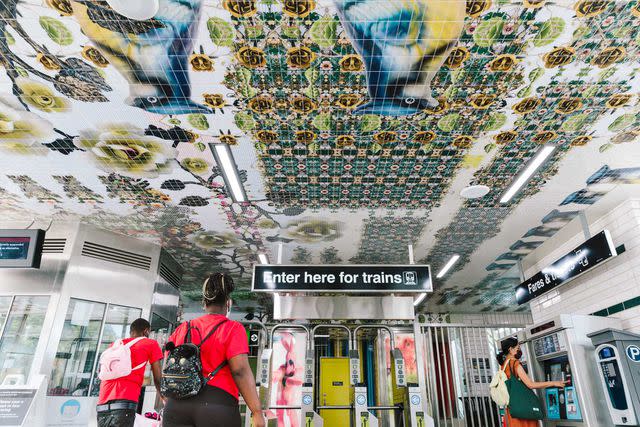
It was a sunny day, and Brown and I walked on through the underpasses, a long gallery of portraits, talking about how city space can be a kind of archive. At 56th Street and Stony Island, we looked at William Walker's landmark Childhood Without Prejudice and Olivia Gude's wonderful 1992 mural Where We Come From…Where We're Going. Gude stopped passersby at this street corner, then painted delicate full-length portraits of the people and their replies to her questions.
"I'm from the Englewood District. It's really hard there."
"All the joy I feel walking around Hyde Park in the spring and the challenge of going back to school after thirty years."
"Basically I was coming from a disaster lifestyle. Now I'm in tune. I'm just walking my faith now."
"Where are you coming from?" Gude had inquired. "Where are you going?" Art often wants to ask passersby these questions; sometimes it can be easier to hear them, and to answer, outdoors.
Another day, I walked to the Hyde Park Art Center, which has a venerable history of discovering and supporting artists from around the city and the world. The industrial garage doors of the main gallery were open, revealing the current exhibition, "Planting and Maintaining a Perennial Garden: Shrouds," by Chicago artist Faheem Majeed.
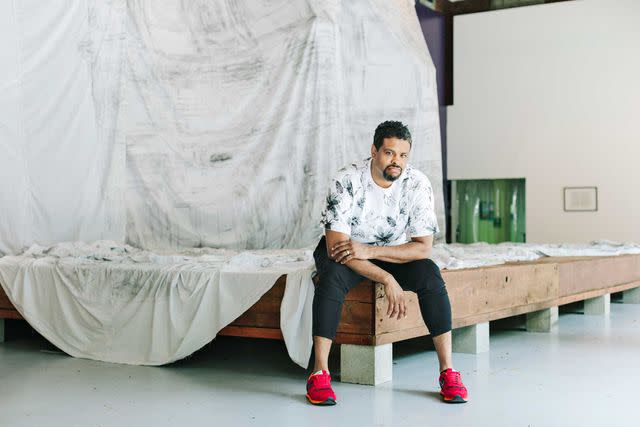
Billowing upward to a height of nearly three stories was a cloth rubbing of the façade of the South Side Community Art Center that Majeed made during the pandemic. Located in Bronzeville, another South Side neighborhood, the SSCAC was founded in 1940, with support from the Works Progress Administration, and is dedicated to honoring its own legacy and nurturing emerging Black artists.
In Majeed's carefully rubbed graphite lines, you can see the bricks and window frames, nail holes and crumbled mortar—details familiar to the creators who have worked within SSCAC's walls. Many of these young artists went on to become widely known, including sculptor and printmaker Elizabeth Catlett; photographer Gordon Parks; and Archibald Motley, painter of the Chicago jazz scene.
It is important to Majeed and to curator Allison Peters Quinn that the Hyde Park Art Center's doors remain unlocked, so casual visitors can wander in. "I'm trying to get outside of the walls," Majeed explained.
Majeed was the director of the SSCAC for six years and knows the building intimately. I asked him whether he had learned anything about it while making the rubbing, and he made a gentle adjustment to my question. The point wasn't to acquire historical information or to produce an artifact, he said, but "to lay hands on the full façade. We were trying to copy something that's living."
It is important to Majeed and to curator Allison Peters Quinn that the Hyde Park Art Center's doors remain unlocked, so casual visitors can wander in.
"I'm trying to get outside of the walls," Majeed explained.
In the neighborhood of Pilsen, the center of Chicago's Lower West Side, there are paintings everywhere: on shop doors, on the side of a dental office, down alleys. At the corner of Cullerton and Wolcott, Mexican-born artist Hector Duarte has painted the exterior of his house with a partly reclining giant whose arm is upstretched to the roof. A twig pattern covers the giant's face and hands, and his fingers and limbs are, disturbingly, bound by barbed wire. The composition is called Gulliver in Wonderland. Duarte studied with the great Mexican muralist David Alfaro Siqueiros, and has been a figure in the Chicago scene for decades. A sign in one window of his home reads NOT FOR SALE.
A block north, at the National Museum of Mexican Art, I looked at an exhibition of Carmen Chami's startling paintings of women who have emigrated to Chicago. An upcoming show is devoted to photographs that belonged to Frida Kahlo and inspired her portraits. I talked with the NMMA's chief curator, Cesáreo Moreno, about whether there is a distinctly Chicago way of making portraits, and he mentioned artists like Kerry James Marshall, Barkley L. Hendricks, Dawoud Bey, and Charles White, whose works he sees as being related to those in murals. They share, he said, an "attention to the ordinary person, the everyday worker, the folk hero."
Related: 10 Best Hotels in Chicago
At the museum, I stood in front of an incandescent mural called The Ancient Memories of Mayahuel's People Still Breathe, by Mario E. Castillo, who was born in the northern Mexican state of Coahuila and moved to Chicago in the early 1960s. Castillo's strange, surrealist work dislocates your senses with swirling eyes and bodies, Aztec sculptures and Day of the Dead skulls, plants indigenous to Mexico and feathered wings.
First shown in 1996 as part of an exhibition honoring the histories of Pilsen and the Little Village neighborhood, this huge painting, framed only by the wall built around it, seemed like it was only resting here for a little while before making its way outside again.
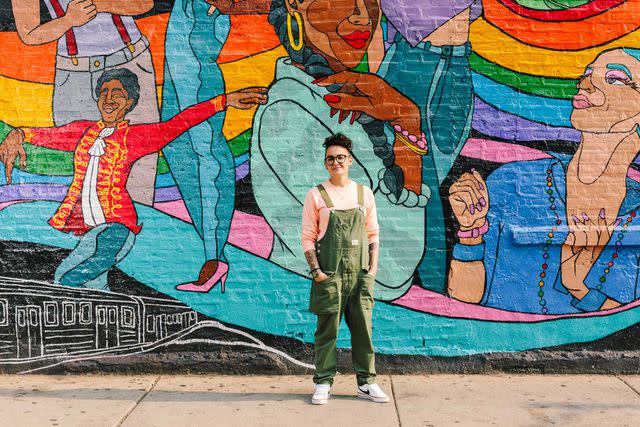
I felt I was following some of the directions in its twisting lines as I went down 18th Street to look at two outdoor murals by the Chicago artist Sam Kirk. The first, Fierce, unveiled for Pride, is a brilliant addition. Against a black background, white line drawings of figures surround a rippling rainbow ribbon that winds among seven full-color people whose postures and styles seem both queer and ordinary.
At the very center a figure in a turquoise dress lifts a large brown hand. People snapped pictures from the bus stop across the street, while a woman stopped and mouthed the word "Wow." A few blocks away, at 16th and Blue Island, is one of my favorite Kirk murals. Weaving Cultures, from 2016, a collaboration with painter and musician Sandra Antongiorgi, portrays five towering visages: ordinary and beautiful women who bear their lifetimes in their faces.
More Trip Ideas: Houston's Incredible Art Scene Is Booming — Here Are All of the Museums and Exhibitions to See
Chicago's deep architectural sense and its appreciation for public art go hand in hand, but when you arrive among the dense skyscrapers, shops, and museums of the Loop, the public art doesn't have quite as much room to breathe. Down a small street that feels more like an alley, Kerry James Marshall's 2017 mural Rushmore, executed by Jeff Zimmermann from a Marshall drawing, covers the back of the Chicago Cultural Center. It shows the faces of 20 women, all significant in Chicago history, among them artist Margaret Burroughs, poet Gwendolyn Brooks, novelist Sandra Cisneros, and Oprah Winfrey. Their faces form tree trunks that reach to a sky threaded with banners held aloft by cardinals.
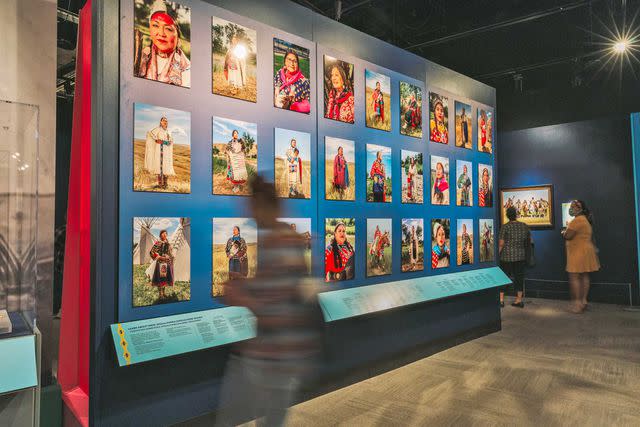
Marshall is one of Chicago's luminaries, and when I visited, I felt sorry that this mural was not in a place where it could make a vital connection with the people on the street. Instead, a worker in a yellow reflective vest and a man in old clothes both tried, self-consciously, to get out of the way of my photographs.
I remembered how, a week or so earlier, on the South Side, when I visited the dazzling tile and glass-screen installations of vines, birds, floral patterns, and textile costumes that Nick Cave and Bob Faust had made throughout the Garfield Avenue CTA stop, it was easy to feel joyous. Patricia Strickland, working at the information booth, took a proprietary pride in my interest, and encouraged me to take pictures.
From Rushmore, I walked across Michigan Avenue into Millennium Park and past the rounded silver landmark of Anish Kapoor's Cloud Gate—polished by the ironworkers of Local 63 and capturing the cityscape and its visitors in its rippled surface. I continued across the elevated skyway to the Art Institute of Chicago. On the roof was a glorious installation of large pieces in metal by preeminent Black sculptor Richard Hunt, born on the South Side in 1935.
Her approach is to treat Native-made works as art rather than artifacts, and to avoid portraying Native cultures as "fossilized in time."
Inside, I noticed that every temporary exhibition space was devoted to the works of artists of color. I saw the landscape drawings of the Black and Native American artist Joseph Yoakum, a self-taught topographical genius; the portraits of the Obamas by Kehinde Wiley and Amy Sherald from the Smithsonian; and, in the galleries usually given over to large shows of European art, a collection of profound quilted portraits by Bisa Butler.
Sarah Kelly Oehler, the museum's curator of arts of the Americas, had suggested in an e-mail that I look at Eldzier Cortor's 1948 painting, The Room No. VI, which shows two adults and two children trying to sleep in a bed that fills most of the room in a small apartment. It would be a counterpoint to Marshall's Rushmore, she wrote, in that it shows "anonymous women in an intimate space."
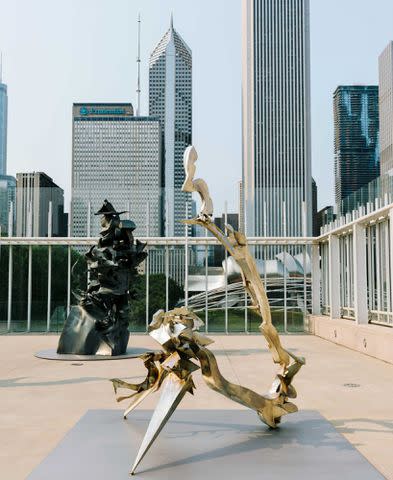
The Room No. VI is a painting of great formal invention and a deep understanding of, as Cortor said, "the confines of the same four walls in a condition of utmost poverty." It's a painting that would be at home, as Cortor himself was, at the SSCAC, which has an Eldzier Cortor Gallery. I thought, as I walked through the next room, looking at Motley's 1943 Nightlife, Catlett's linocut 1952 Sharecropper, and White's 1951 lithograph Gideon, that these museum galleries have tried to reconstitute a view of art long held and nurtured some 40 blocks away, in Bronzeville.
Debra Yepa-Pappan, an artist of Jemez and Korean heritage, is the Native American community engagement coordinator at the Field Museum. In addition to its vast halls of dinosaurs and elephants, the Field has huge collections of art from all over the world, and for the past several years has been figuring out how to honor the works and their makers while acknowledging the exploitative ways these pieces often arrived at the museum.
Yepa-Pappan walked me through the Native American Exhibition Hall, which will open next spring after being reimagined from the ground up. When we stood together in what was still a dark construction space, she explained the plans for the new exhibits. The co-curators from different tribes who serve on the advisory board did not want glass cases full of artifacts—they wanted stories, voices, and a living sense of significance. In response, the Field is paring the displays down from more than 1,600 objects to just 250, and adding new works by contemporary artists.
The hall will be organized around five narratives: one section dedicated to Chicago and the Great Lakes, the rest rotating to cover other regions of the country. Technology is an important part of these projects, with films that give context and recorded interviews. Perhaps most significant is the orientation away from nostalgia and the past, toward the future.
Alaka Wali, the Field's curator of North American anthropology, initiated collaborations with Native artists and curators. Her approach is to treat Native-made works as art rather than artifacts, and to avoid portraying Native cultures as "fossilized in time." Wali's hope is that this model will affect the way other museums contextualize their collections.
Both Wali and Yepa-Pappan told me to go downtown to see Grand Portage Ojibwe artist Andrea Carlson's new banners on Chicago's bright Riverwalk, a place of architectural boat tours and tourist cafés. When I went, a few days later, I found a sense of harmony in standing on the DuSable Bridge, thinking of the portrait of DuSable in the underpass in my own neighborhood; remembering his wife, Kitihawa; and looking at five large banners, the first two of which bear the Potawatomi phrase Bodewadmikik Éthë Yéyék, which is translated over the last three: YOU ARE ON POTAWATOMI LAND.
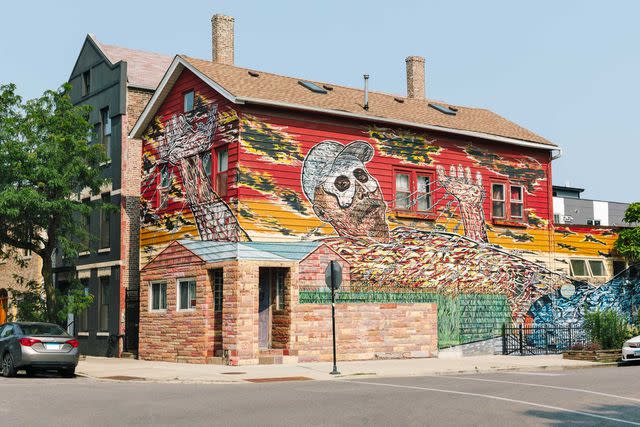
On Juneteenth 2021, the 77-year-old artist Arkee Chaney and I stood near the DuSable Museum of African American History in Washington Park. Each of us held a brush and a cup of paint as we worked on a mural designed by incarcerated artists as part of the Prison+Neighborhood Arts Project. Chaney showed me how to steady my hand against the board. "Don't be afraid of the paint," he said, "or it'll beat you."
Chaney told me about being a student of Margaret Burroughs during the 31 years he was in prison. "I loved her," he said. "She was like a mother. She always had paintbrushes and paints for me." Burroughs was a visionary who was not only instrumental in founding the SSCAC but also established the DuSable, the oldest museum of Black culture and history in the country. She believed that art should circulate.
Majeed told me about working with her at the SSCAC, and how she would send him upstairs to photocopy her prints for people she liked. Along with its historical exhibitions, the DuSable holds a collection of linocuts by Burroughs and works by some of her incarcerated students. On quiet days, you can look at these with just a few other, purposeful visitors; sometimes, as on Juneteenth or when there are special outdoor concerts, there is a festive crowd.
Legacies were on my mind again a few weeks later, when I stood a few blocks north, at 37th and Langley, to see the just-unveiled memorial that sculptor Richard Hunt made to honor journalist, anti-lynching activist, and educator Ida B. Wells. Light of Truth is a complex, curving, pointed bronze sculpture that rises 20 feet into the air. A few other people had come to pay their respects to Wells and Hunt; the atmosphere was reverent and courageous. "It is a beacon," Majeed said to me later.
It was a summer of walks and efforts, neighbors, curators, paint, movement, working in public. Light of Truth is a place to look upward and think. No one has a finer sense than Hunt of how to concentrate Chicago's metallic architectural language, the city's difficult history, and the force of its prairie sky.
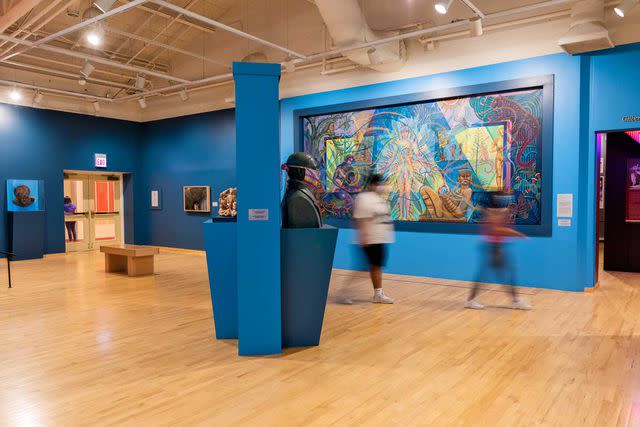
Following Chicago's Art Trail
Where to Stay
The Pendry: A few blocks from the Art Institute, this Art Deco–style hotel occupies the landmarked Carbide & Carbon building. Doubles from $396.
Sophy Hyde Park: This boutique property on the South Side is close to many landmark murals and has a great bar. Doubles from $224.
21c: The Chicago outpost of this hotel brand has rotating contemporary art exhibits. Doubles from $113.
What to Do
Art Institute of Chicago: You'll need ample time to explore the city's largest museum, which is mounting a Barbara Kruger retrospective this fall.
DuSable Museum of African American History: Founded in 1961, the DuSable is the country's oldest museum dedicated to Black history and culture.
Field Museum: One of the world's great science museums has reimagined its exhibits of Native American art and artifacts.
Hyde Park Art Center: This contemporary-art haven hosts classes and open-studio visits, artists' talks, and rotating exhibitions.
National Museum of Mexican Art: A sprawling collection that encompasses 3,000 years of Mexican history.
South Side Community Art Center: Founded in 1940, the center has a robust permanent collection of works byBarbara Jones-Hogu, William Walker, and other important Black artists.
A version of this story first appeared in the October 2021 issue of Travel + Leisure under the headline An Urban Canvas.
For more Travel & Leisure news, make sure to sign up for our newsletter!
Read the original article on Travel & Leisure.

